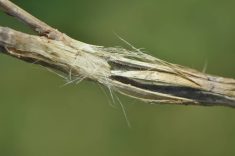When seeding is delayed, optimizing stand establishment becomes imperative to achieving maximum yield. Remember, planting date is only one of many yield-influencing factors. The following tips can assist in maximizing seedling emergence and establishment.
AVOID “MUDDING” IT IN
Manage crop residue, drive on firm fields, and leave the drowned-out spots to dry. Early seeding favours higher yields, but does not guarantee them. Most farmers have the machinery capacity to catch up quickly once soil conditions improve. The following information from MASC (2005-10) shows how quickly major crops like spring wheat and canola can be planted.
Read Also

Canadian canola prices hinge on rain forecast
Canola markets took a good hit during the week ending July 11, 2025, on the thought that the Canadian crop will yield well despite dry weather.
On average 47 per cent of the spring wheat crop is planted in the first two weeks and 56 per cent of canola crops planted in the second and third week of May. Farmers have planted 60 per cent of the province’s wheat crop, and 42 per cent of the canola crop, in a single week given good working conditions.
INCREASE YOUR RATE OF GERMINATION AND EMERGENCE
Delayed emergence is equivalent to seeding date delays, resulting in an equal reduction in yield. Determining soil temperature can indicate how quickly seed will germinate and emerge and can assist in crop-seeding sequencing.
Soil temperatures should be measured and seeding targeted when the soil temperature at seeding depth reaches or exceeds the required minimum (Table 1). Measure temperature at the desired seeding depth, and when soil is at its coolest (early morning) and warmest (late afternoon). Targeting a shallower seeding depth can place seeds in warmer soil, which could result in faster germination.
STEADY AS SHE GOES
As seeding dates are pushed back, it may be a natural impulse to seed as many acres, as fast as possible. However, research has consistently shown that uniformity of seed placement (depth) is one of the first things lost once planting speeds exceed five m.p.h. So during seeding, continually check to ensure proper depths are achieved.
PLANT QUALITY SEED AND CONSIDER A SEED TREATMENT
Using certified seed with high germination is optimal. If you haven’t already tested your seed source, now is the time, as it is the only reliable means of determining germination and disease presence. As well, look for seeds with good test weight, colour, size uniformity and no indication of disease (shrivelled, discoloured). If the seed looks questionable and per cent germination low, sell it into the commodity market and secure better-quality product.
In addition to quality seed, seed treatments have been shown to have their largest benefits in cool and wet soils by minimizing seed-and soil-borne disease. Healthy seedlings, regardless of crop type, can assist in overcoming other early-season challenges and protect yield potential.
TARGET A PLANT STAND AND SEEDING RATE
Good plant stands can spread out the impact of early-season challenges and provide extra insurance and compensate for lost plants due to early insects, frost and disease.
Plant stands are calculated based on seeding rate, thousand seed weight and expected seed survival (includes germination and mortality).
Table 2 has the following recommendation from MAFRI for plant stands. Use the table and the following equation to determine seeding rates to achieve the plant stands. Note, mortality rates for oilseeds, especially canola are typically much higher than cereals.
ENSURE ADEQUATE FERTILITY AND REDUCE WEED COMPETITION
Supply adequate nutrition (nitrogen, phosphorus, potassium and sulphur) to meet your target yields and limit weeds with a pre-seed burn-off. This will assist in better establishment due to reduced plant competition and increase fertilizer availability for the crop.
Finally, regardless of when planting does begin, it is important to remember that things overlooked during seeding cannot necessarily be made up later in the season, effectively putting a “ceiling” on the crop’s yield potential before the plants have even emerged.
Now is not time to change crop types, switch into shorter-season varieties or to start broadcast seeding. The month of May still has almost three weeks left and May is typically when 90 per cent of Manitoba’s crop is planted with successfully high yields.
———
GRAIN CROPS
Table 1: Minimum Germination Temperatures for Various Crops
Barley
TEMPERATURE (C) 3 -5
Wheat
4
Oat
5
Corn
10
OILSEED CROPS
Canola
5 -10
Sunflower
6 -7
Flax
9
Peas
4
Source: North Dakota State University Extension Service, Alberta Agriculture &Rural Development, Canola Council of Canada
Table 2: Optimal Plant Stands for Various CropsPlants/ft2
Plants/ac (1000s)
Mortality Rates (%) Barley
GRAIN CROPS
Wheat
22-25 23-28 18-23
–
– Oat
– Corn
–
26-30
OILSEED CROPS
Canola
7-14
–
10-15 10-15 10-15 10-15 20-60
Sunflower
-–
18-22
10
*Navy Bean = pinto beans on lower end and navy bean require higher plant stands
Source: MAFRI website (plants stands), MAFRI crop specialists, Canola Council of Canada, Flax Council of Canada, Ontario Ministry of Agriculture, Food and Rural Affairs
Flax Peas
37-56 7-9
-–
40-50 5-15
PULSE CROPS
Soybean
10
PULSE CROPS
Soybean
-–
Dry Bean
10 -12
Dry Bean*
–
– 180-210 85-100
5-10
5-10
———
(lbs./ac.)
Seeding Rate= target plant stand per ft2 x 1000 seed weight (grams)
per cent expected seed survival x 10
e.g. FLAX Seeding Rate = 45 plants/ft2 X 5 g (1000 seed weight) = 43 lbs./ac. [88 per cent germination x (1-40 per cent mortality)] X 10
Also see http://www.gov.mb.ca/agriculture/crops/cereals/bff01s02.html
for more information.


















